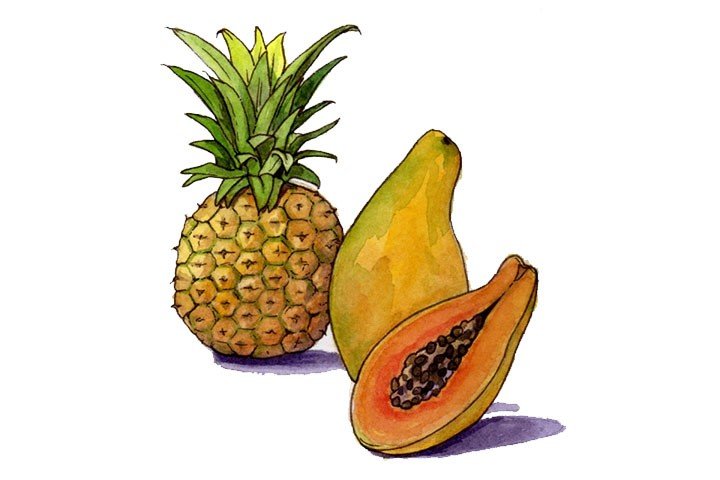
For Patients & Caregivers
Tell your healthcare providers about any dietary supplements you’re taking, such as herbs, vitamins, minerals, and natural or home remedies. This will help them manage your care and keep you safe.
What is it?
Proteolytic enzymes have not been shown to prevent or treat cancer.
Proteolytic enzyme (PE) treatments were first used in Germany in the 1960s for inflammation, osteoarthritis, autoimmune diseases, and viral infections. The products usually contain a mixture of pancreatin, papain, bromelain, trypsin, and chymotrypsin.
Lab studies suggest that PEs can affect the growth of cancer cells. Although PEs were previously reported to benefit patients with cancer, more recent studies do not support such claims. However, PEs may be useful in reducing pain associated with moderate-to-severe knee osteoarthritis.
What are the potential uses and benefits?
- Inflammation
Observational studies suggest benefit, but clinical data are lacking. - Autoimmune diseases
Evidence is lacking to support this claim. - Viral infections
Evidence is lacking to support this claim. - Cancer and treatment-related symptoms
Data from clinical studies are conflicting. - Hepatitis C
Evidence is lacking to support this claim.
What are the side effects?
- Gastrointestinal disturbance
- See also Bromelain
What else do I need to know?
Do Not Take if:
You are taking anticoagulants (warfarin): Bromelain may increase bleeding risk due to its antithrombotic effects observed in lab experiments (17), but clinical relevance is not known.
See additional bromelain interactions.
For Healthcare Professionals
Brand Name
Clinical Summary
Proteolytic enzyme (PE) treatments were first popularized in Germany in the 1960s for inflammation, osteoarthritis, autoimmune diseases, and viral infections. The products usually contain a mixture of pancreatin, papain, bromelain, trypsin, and chymotrypsin. Preclinical studies indicate that PEs have immunomodulatory and tumoricidal properties (1) (2) (3) (4) (5) (6). Such effects are thought to result from degradation of abnormal immune complexes.
In clinical studies, oral administration of PEs to healthy volunteers resulted in immunomodulatory effects (7). Systemic therapy with PE before and after exhaustive exercise increased maximal concentric strength and had favorable effects on inflammatory, metabolic, and immune biomarkers (18). In a randomized trial of subjects with moderate-to-severe knee osteoarthritis, oral PE had effectiveness comparable to diclofenac in relieving pain and increasing function (19).
Although some clinical and epidemiological studies suggest benefit with adjuvant PEs in patients with head and neck cancers (8), multiple myeloma (9), breast cancer (10), and cervical cancer (11), conflicting data do not support the findings (12). A randomized controlled trial also failed to find sufficient evidence to support use of PEs for preventing mucositis (13). Further, results from a study involving patients with inoperable pancreatic cancer showed a decrease in overall survival and poorer quality of life with PEs compared with standard gemcitabine-based chemotherapy (14).
Findings from two meta-analyses suggest that PEs may be useful for preventing acute radiation-induced skin reactions (20), but more studies are needed to confirm such effects.
Food Sources
Pineapple stem is a good source of bromelain. Papain is obtained from the papaya plant and fruits.
Purported Uses and Benefits
- Cancer
- Treatment-related symptoms
- Hepatitis C
- Immunomodulation
- Inflammation
- Infections
Mechanism of Action
PEs are thought to exert immunomodulatory effects by causing increased release of reactive oxygen species by polymorphonuclear leukocytes (7) or by production of tumor necrosis factor-alpha and interleukins IL-6 and IL-1B that cause cytotoxic effects (1) (2). The anti-angiogenic effects exhibited by papain in VEGF-activated human endothelial cells are concentration-dependent and likely due to interference with AKT, MEK1/2 and SAPK/JNK phosphorylation (15). Bromelain has been shown to lower the tumorigenic/metastatic capacities of sarcoma L-1 cells (3). It also inhibited glioma cell migration and invasion by affecting expression of integrins, necessary for cellular migration and invasion (5). In B16 murine melanoma models, PEs inhibited metastasis by reducing expression of CD44 and CD54 molecules (6).
Herb-Drug Interactions
Anticoagulants (warfarin): Bromelain may increase bleeding risk due to its antithrombotic effects observed in preclinical experiments (17), but clinical relevance is not known.
See additional bromelain interactions.